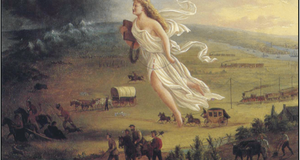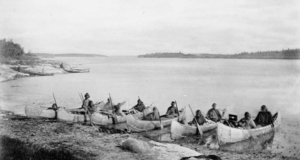The Mystery of Miracles: Examining Religious Providence in the Sixteenth-Century Captivity Narratives of Hans Staden and Cabeza de VacaIt is quite clear, then, that a strong argument exists for conscious self-fashioning; both Staden and Cabeza de Vaca saw themselves as representatives of Christianity in a hostile and pagan world, and therefore may have followed the long-established tradition of portraying themselves as de facto martyrs. Another facet of the miracles – one that does not necessarily contradict this one, however – must also be examined. Necessity. If given full sovereignty over their own decisions, it is not clear that either would have elected to assist the native people; though Cabeza de Vaca formed quite a personal relationship with some of them over the years. Neither man, in truth, was faced with much choice in the matter. It is not that Cabeza de Vaca and Hans Staden were irreligious. There was no other option but full belief in the sixteenth century, and the concept of miracles was a commonplace one. “There is no question,” states historian Daniel T. Reff, “…that Cabeza de Vaca was the product of a culture that embraced the idea of miracles and supernatural intervention, particularly when it came to the conquest and conversion of gentiles.”15 We know that the same was true for Staden. True conviction among these men, then, was likely a given. They certainly had hope that they could exercise such incredible power, as their very lives depended on it. They were desperate for God’s aid, faced with an impossible situation, and the natives were similarly desperate for the god-like saviors they so waited for – their own legends and traditions had long foretold the arrival of mysterious visitors, and they were eager to test the power of these strangers. Reff argues that Native Americans were predisposed to cast Cabeza de Vaca and his men as shamans, citing another historian as suggesting that the Quetzalcoatl myth may have been current among these peoples: “When confronted with strangers who originated in the east – where Quetzalcoatl dwelled – the Indians are said to have reasoned that Cabeza de Vaca and his party were related to supernaturals (‘children of the sun’).”16 Even given the nearly certain piety of both men, an unerring belief in God does not instill complete confidence regarding the possibility of miracles. Society of the sixteenth century was exploring new and more classically traditional medicines, developing scientific practices and approaching an understanding of the world outside of religion – though the Church had not declined in importance. Cabeza de Vaca certainly felt the idea of healing, at least initially, to be ludicrous: “…They tried to make us physicians without examining us or asking for our titles, because they cure illnesses by blowing on the sick person… We laughed about this, saying that it was a mockery and that we did not know how to cure,” he related.17 This proved not to be the ideal reaction, as the natives took away the food of their captives until Cabeza de Vaca and his men would do as they said.18 Loss of sustenance is the essence of necessity, and these men had to have been praying hard that their healing methods would work – even mere coincidence might have convinced them, and the Indians, of the efficacy of these practices. Scholar Rolena Adorno elaborates upon this point: “Since starvation was a threat… becoming shamans was an effective way to fend off [starvation] and assure the friendly attitude of the natives in spite of the devastating population losses they suffered.”19 Often, great rewards were even to be had for continuing their supposed healing practices. Cabeza de Vaca told how the natives would claim their complete restoration upon being ‘cured’, and “…On account of this they treated us well, and refrained from eating in order to give their food to us, and they gave us skins and other things… Many other sick people came that night to be cured. And each one brought a piece of venison. And there were so many of them that we did not know where to put the meat.”20There are many instances of Cabeza de Vaca and his compatriots healing men by “making the sign of the cross” and blowing, but one invariably sticks out from all others: the account of a ‘dead’ man being brought to life. This can either be viewed as proof that something real was happening, proof of possible Indian deception for their own benefit (a concept I will further explore later) or proof that the account had been invented, perhaps now moving too far past the point of believability. Either way, it is endlessly fascinating. Frantic people of the village had approached Cabeza de Vaca, claiming there was a man near death – or there already – who desperately needed his ability to enact divine intervention. “I saw the sick man whom we were going to cure, who was dead… his eyes rolled back in his head, and without any pulse, and with all the signs of death… And after having made the sign of the cross and blown on him many times… We returned to our lodgings, and at nighttime they returned to their houses and said that one who had been dead and whom I had cured in their presence had arisen revived and walked about and eaten and spoken with them.”21 Whether truthful or not, Cabeza de Vaca does not miss out on the opportunity to claim the reputation he earned among the native peoples, stating that in his boldness and in his willingness he became the most notable of all physicians.22 Is this a statement of truth, or another example of possible self-fashioning? The miracles discussed in Staden’s account are quite different than in that of Cabeza de Vaca. While the Tupinimbá did enlist him to help with healing, it was through prayer and not necessarily overt practice; though native reaction to his seeming power was strong nevertheless. When bad things happened, it was because Staden’s God was angry, and when good things happened, it was because the people had redeemed themselves in some way. Weather was the main conduit for Staden’s miracles. In countless instances, upon the command of the Indians, he was told to “speak with his God” so that dark clouds or storms would move away – and, if we are to believe the account, his prayer’s supplication would always make them do so. One memorable anecdote involved great rain during a journey from another village: “…They told me to make the rain stop. Now there was a boy with us who still had a piece of the leg bone of the slave with some flesh on it, which he was eating. I told the boy to throw it away.”23 After the boy protested, Staden dropped the matter, but the weather continued to worsen: “The boy continued gnawing the flesh off the bone. Then he threw it away… The weather then immediately improved.”24 Staden subsequently claimed to the Indians that his God had been angry that human meat was being consumed; He had rewarded them all with pleasant weather after the offensive leg bone had been discarded. Similar instances include the taking down of a cross that Staden had made, ensuing stormy weather, and an improvement once the natives helped him construct a new one. These situations were highly fortuitous, to be sure, for Staden, but they also – if we take them as truth – could be purely coincidental. All were looking for religious explanations to what were often natural solutions. Fear and reverence, however, seemed incredibly real and universal among the native populations of both narratives. People started having fearful dreams about Staden, and those who had once done him harm “…Now called me Scheraeire, which means: ‘my son’,” he recounted.25 His power, in fact, is what apparently convinced the Tupininbá that he was not Portuguese: “Their God never got as angry as yours,” the natives asserted.26 The most egregious display of respect and fear of Cabeza de Vaca was exhibited near the end of his Naufragios, during a long land journey that had seen death from disease and hunger. He claimed that prayer had helped to heal the sick, and that all who lost loved ones had begun to stop their displays of grief. Soon it becomes clear that this was no miracle, but rather a concerted effort on the part of the natives to satisfy Cabeza de Vaca. One woman who wept openly was taken aside and cut with the sharp teeth of a rat from her shoulders to the bottom of her legs. “I asked them why they did it,” wrote Cabeza de Vaca, horrified by such an action, “...and they responded that it was in order to punish her because she had wept in front of me.”27 Such a vivid incident was likely not invented by Cabeza de Vaca, and it seems clear that some very real effect was felt among the Indians. Did they truly believe in these new supernatural beings from the east? Did they see these white-skinned men as part of the Quetzalcoatl myth? Were the natives simply desperate for aid, fearful of these new and strange people and willing to believe anything?Continued on Next Page » Suggested Reading from Inquiries Journal
Inquiries Journal provides undergraduate and graduate students around the world a platform for the wide dissemination of academic work over a range of core disciplines. Representing the work of students from hundreds of institutions around the globe, Inquiries Journal's large database of academic articles is completely free. Learn more | Blog | Submit Latest in History |
















